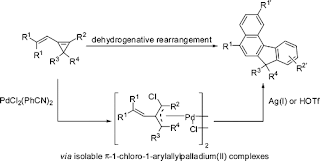
Taken from Ref. [1].
This week we will look at a ‘Nobel-Prize’ star – the olefin metathesis reaction. Metathesis is the process in which 2 olefinic fragments are redistributed to afford a new olefinic product, with ethylene (in most cases) as a side-product. Metathesis is an extremely useful reaction in natural product and polymer synthesis, and no doubt a number of its variations are developed. The catalysts involve either Ruthenium (Ru) or Molybdenum (Mo). While Ru-based catalysts are very general in natural product synthesis, Mo-based catalysts tend to be more selective for certain kinds of substrates.

Figure 1. Olefin Metathesis and Stereochemical Rationale. Taken from [2].
While strategies such as Ring-Closing Metatheses (RCM) are widely employed in synthesis, the prospect of the metathesis reaction has a long way to go. One of the most challenging types of metathesis is ‘the’ cross-metathesis (CM). It represents the reaction between 2 different olefins (e.g. A and B) to afford the required product, A-B. From the mechanism, it is inevitable that homocoupling can often take place to give statistical mixtures of A-A and B-B, which are undesirable products in the synthetic perspective (Figure 1) [1,2].
Furthermore, cross metathesis produces the thermodynamically-feasible E-olefin products, yet it rarely produces Z-olefins(Figure 1). The difficulty concerning the Z-isomer synthesis is originated from the reversibility of the metathesis process. Since a Z-alkene is more reactive than an E-alkene, it is more likely to engage in the reversible reaction and thus retard the metathesis process. While a certain class of cross metathesis, the ring-opening cross-metathesis (ROCM) shows some promise as the relief of ring strain of the substrates can provide a thermodynamic driving force, this privilege is not shared by the common olefinic substrates in a normal cross metathesis. Thus, it is clear that a Z-selective cross metathesis reaction should be a highly sought-after process.

Figure 2. Olefin Metathesis by Hoveyda, Schrock et. al. Taken from Ref. [1].
This week, we have an article in ‘Nature’ from Hoveyda and Schrock et. al., which features a chiral-at-metal Mo catalyst for Z-selective cross metathesis (Figure 2) [1]. By careful ligand design, they can encourage the formation of Z-isomer product through the formation of the corresponding metallocyclobutane intermediate, for which its formation is encouraged because the bulky, monodentate arylalkoxide ligand can rotate freely to enable that to take place (Figure 3) [1, 2].

Figure 3. The stereochemical rationale proposed by Hoveyda et. al. Taken from [1].
They have investigated Z-selective cross-metathesis in 2 groups of substrates – enol ethers and allylic amides. It is indeed a great choice to try the enol ether as it has the advantage that it is more electron-rich and therefore it can form a more stable alkylidene intermediate, which will lead to a longer catalyst lifetime and thus a better turnover. The group has also optimized the equivalents of enol ether used in the reaction, so that they can ensure the higher conversion possible along with the highest Z:E isomer ratio.
Another key issue they have looked into is the potential of formation of other side-products through the reaction of ethylene (CH2=CH2), which is inevitably generated through the metathesis mechanism. The group has devised a trick to exclude this ‘not-so-innocent party crasher’ in the metathesis reaction. By carrying out the reaction under reduced pressure, ethylene could be extruded from the reaction medium. This restored the conversion and stereoselectivity, and attenuated the effects enacted by intermediates associated with ethylene, such as unproductive cross-metatheses and further olefin isomerizations.
In order to demonstrate the strategy’s versatility, they have employed their metathesis reaction in 2 examples of natural product synthesis - a plasmologen phospholipid and the immunostimulant KRN7000.
The work was also covered in the article by Lee. [2]
References:
1. Catalytic Z-selective olefin cross-metathesis for natural product
synthesis.
Simon J. Meek, Robert V. O’Brien, Josep Llaveria, Richard R. Schrock, Amir H. Hoveyda
Nature 2011, 471, 461.
2. Overcoming catalytic bias
Daesung Lee
Nature 2001, 471, 452.














































